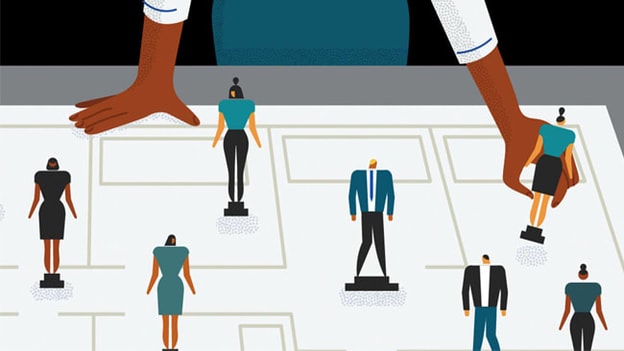Re-creating the workplace magic through personalized employee experiences

“In a world where money is no longer the primary motivating factor for employees, focusing on the employee experience is the most promising competitive advantage that organizations can create.” - Jacob Morgan, keynote speaker, futurist and author of The Employee Experience Advantage
The pandemic induced ‘Super-VUCA’ times have seen organizations trying hard to re-invent psychological contracts as employees expect a lot more security, safety, compassion and empathy from their employers. Ian Cook, VP, People Analytics, Visier Inc. refers to the last few months as ‘the great resignation’ that has seen many mid-career employees resigning from their jobs. This has kept employers on their edge with respect to their talent retention strategies were delivering a superior employee experience seems to be the only possible answer. And delivering unique employee experience, in these times, is not possible without hyper-personalizing them after a thorough understanding of the organizational DEI aspects. Mckinsey advocates personalizing social, work, and organizational experiences for employees to sustain through these difficult times.
So, here are certain steps that organizations could take to hyper-personalize employee experiences in order to strengthen their talent retention strategies and enhance employee morale:
Fostering Personalized Individual Relationships
Organizations like Air-Asia, Airtel or ICICI have used mobile-based AI platforms for employees to independently engage with their line managers, HR partners, peers, and leaders. This is even more important in a period like such where organizations fear a huge reduction in social capital and emotional bonding between employees. Coca-Cola used a Vietnamese version of the ‘Leena AI’ to make things simpler for its Vietnamese blue-collar workers who found it difficult to access the bot in English. Others like Google, Adobe, or Microsoft encourage managers to engage in frequent informal conversations termed as “check-ins” with their subordinates.
Hyper-Personalizing Total Rewards
Total Reward Leaders are today talking about hyper-personalizing rewards to meet the unique needs of employees. Organizations could look at redesigning their existing plans to suit the needs of various employee groups. For instance, Schneider pays back the saved premium on group health insurance plans as cash rewards to their young Graduate-Engineer-Trainees who insure only themselves (and not other family members). Tech Mahindra has introduced retention bonuses for key talent, skill-based allowances for niche skills and project-based bonuses for critical projects. Organizations like BNY Mellon, Schneider, or Air-Asia are prioritizing employee well-being and wellness by providing free-health check-ups, telemedicine and counselling services to employees.
Encouraging Flexi-policies at Work
With the pandemic inducing unforeseen uncertainties into life, employees view flexi-policies as a proxy for organizational compassion and empathy. As per a Statista survey of more than 3500 employees across the globe, 43% of employees are in a hybrid work model whereas 30% are permanently working from home. Giving each employee the right amount of flexibility can turn out to be a substantial competitive advantage for a long-term impact. For instance, Telekom Malaysia considered employee demographics, medical conditions, work-styles and preferences to cluster employees into high, medium and low-risk categories and customized the Return to work strategy accordingly. Verve Logic – a Jaipur based IT firm provided Netflix leave to its employees to watch money heist season 5 to cheer up employees in distressing times.
Gamifying Organizational Processes
Gamification innovatively integrates game principles into a non-game process, creating a distinctive and ‘learn-through-fun’ experience for employees. The level of interaction in a gamification process can be personalized as per the employee’s demographics, interests, preferences, and responses using AI-based automation. Training is an area that most employees would love to see gamified. Using gamification in a training module gives the employee an option of re-playing and improving on past decisions to enhance results. For instance, Domino’s pizza could train new joiners much faster on their pizza maker course by gamifying the whole process. Cisco saw a huge up-take of its social media training module after it gamified it into three certification levels - Specialist, Strategist and Master.

Work Applications that employees would love to see gamified as per the TalentLMS’s 2019 Gamification at Work Survey
Redesign Learning & Development to align with employee needs and interests
Employees vary in their need to learn and their capability to absorb and convert learnt concepts to workplace performance. Different employees also prefer different modes of learning. Having an automated Learning Management System goes a long way in catering to different employee learning needs. Gamification or programmed instructions facilitate self-paced learning and are preferred by employees. Organizations must foster a learning environment where employees feel encouraged to learn as well as transfer their learning to improve performance. Codaemon, a mid-sized Pune-based IT firm let go of old clients after an employee opinion survey where employees expressed their interest to work on newer technologies for their career development and raised their grievance that the older clients were not using these newer technologies. Thus, the firm prioritised its employees over its clients.
Charting an employee-specific career path
Organizations must enable multiple career path options for employees depending on their competency, performance, feedback, and above all the employee interest. As companies move towards a more talent-based approach, employee learning and aspirations should be prioritized to chart their career graph. For instance, NSE provides employees to choose between a specialist or a generalist career path for both groups – high performers who are under the fast-track career progression and the normal performers who follow the normal career progression plan.
Prioritising employee well-being and wellness
Personalizing employee experience goes a long way for an organization to manage its attrition rate and implement a successful talent retention strategy. And in these tough times, a competent and motivated workforce is the only competitive advantage that organizations have.















